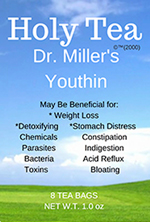Get 10 Mini Packs Iaso Instant Herbal Detox Weight Loss Tea For $20 Burn Fat Fast Free Shipping

What Are The Ingredients In Dr. Miller Holy Detox Herbal Tea
Dr. Miller’s Tea is a Herbal Detox Tea. The tea is organic and natural. The tea is made 9 Powerful. These 9 Powerful Herbs are designed to totally detox the body and reduce constipation. These 9 Powerful herbs will clean the colon and digestive system. The side effects are minimal. This tea does not have the laxative senna or caffeine.
Marsh Mallow (also known as Sweetweed)
The Marsh Mallow or Marshmallow (Althaea officinalis) was used in ancient Greece to remedy bruises and bleeding, and as a mild laxative. It was used in medieval Europe for indigestion and diarrhea. The Marsh Mallow root or leaf was traditionally used to soothe and support the intestines. It is rich in calcium, zinc, iron, sodium, iodine, vitamin B complex, and pantothenic acid. Herbs high in mucilage, such as Marsh Mallow and Malva Leaf (of the same family), are often helpful for symptomatic relief of coughs and irritated throats. Mallow has expectorant and demulcent properties, which accounts for this herb’s historical use as a remedy for the respiratory tract, particularly in cases of irritating coughs with bronchial congestion. Marsh Mallow root and, to a lesser extent, Marsh Mallow leaf both contain significant percentages of mucilage, a natural gummy substance that does not dissolve in water. Like other mucilage-containing substances, Marsh Mallow swells up and becomes slick when it is exposed to fluids. The resulting slippery material coats the linings of the mouth, throat, and stomach to relieve irritation and control coughing associated with respiratory conditions such as smoker’s cough. For example, Marsh Mallow has been used to treat sore throats and to alleviate heartburn, and was originally the main ingredient in making a candy-like medicinal lozenge. Marsh Mallow may also have mild anti-infective, immune-boosting, and diuretic properties. In the British Herbal Compendium the use of Marsh Mallow is listed for gastroenteritis, peptic and duodenal ulcers, colitis, and enteritis. Topically, Marsh Mallow is used to soothe and soften irritated skin, and as a remedy for cuts, wounds, abscesses, boils, burns, and varicose veins. The edible leaves are used as an ingredient in green salads in France.
Blessed Thistle
Blessed Thistle (Cnicus benedictus or Carduus benedictus) has been used in traditional medicine as far back as the early sixteenth century as an appetite stimulant, astringent, blood purifier, choleretic (bile flow stimulant), diaphoretic (sweat stimulant), digestion enhancement, diuretic (increasing urine), expectorant, fever reducer, memory improver, menstrual flow stimulant, and salivation stimulant. It was cultivated in monastery gardens in Europe as a cure for smallpox and is named in honor of St. Benedict, the founder of a holy order of monks. It is still used as a flavoring ingredient in their Benedictine liqueur. Shakespeare mentioned “distilled Carduus benedictus” in his stage play, Much Ado About Nothing. Blessed Thistle has been used for smallpox, malaria, fever, anorexia, dyspepsia, indigestion, chronic constipation, and flatulence. More recently studies have shown it to be useful for indigestion, heartburn, and poor appetite. Blessed Thistle helps increase appetite in people with digestion or eating disorders such as anorexia (but does not increase the appetite of normal people). In herbal medicine, Blessed Thistle is used for cancer, infections, inflammation, gallbladder disease, jaundice, liver disorders, cervical dysplasia, heart ailments, skin ulcers, yeast infection, and diarrhea. Though it has also been used traditionally to stimulate breast milk flow, Blessed Thistle should not be confused with a different milk-stimulating plant called Milk Thistle or Holy Thistle (Silybum marianum) (which is another ingredient of Dr. Miller’s Holy Tea).
Holy Thistle (Silybum marianum) supports the liver in the release of toxins. Holy Thistle has been used medicinally for over 2000 years, most commonly for the treatment of liver disorders such as jaundice, and gallbladder disorders; but also for lactation problems, disorders of the spleen, psoriasis, and mushroom poisoning. It has recently been used by HIV-positive patients to protect the liver from diseases such as hepatitis and damage from the drugs taken for HIV or AIDS. A flavonoid in the fruit called Silymarin (with its most active beneficial component called Silibinin or Silybin) is a powerful antioxidant, and may also protect the cells of the liver by blocking the entrance of harmful toxins and helping remove the toxins from the liver cells. Silymarin has also been shown to regenerate injured liver cells. It stimulates liver and gallbladder activity and may have a temporary mild laxative effect in some people. Products with Holy Thistle as main ingredient are popular in Europe and the United States for various types of liver disease, being able to counteract the harmful actions of alcohol on the liver (cirrhosis), and helping the liver return to a healthy state when an alcoholic stops drinking. Some clinical trials with Silymarin indicate that it may improve quality of life and even increase life expectancy in patients with cirrhosis of the liver. Holy Thistle is believed to have great power in the purification and circulation of the blood, and is such a good blood purifier that drinking a cup of Holy Thistle tea twice a day is believed to cure chronic headaches. It is also used for stomach and digestive problems, gas in the intestines, and constipation relief. It is very effective for dropsy, strengthens the heart, and is good for the liver, lungs, and kidneys. It was claimed that warm Holy Thistle tea given to mothers will produce a good supply of milk, which led to this thistle being called by another name: Milk Thistle. Holy Thistle is also said to be good for girls entering womanhood, as a good tonic. The leaves and stems of Holy Thistle are used in Europe as ingredients in making a green salad.
Persimmon Leaf
Persimmon (Diospyros kaki) originated in China and has been grown for over 1000 years in Japan, which is the leading producer today. A similar variety of the Persimmon fruit (Diospyros virginiana) grows in the Eastern USA and is called Pawdad. The tannins and flavonoids in Persimmon leaves have anti-hypertensive, anti-carcinogenic, and anti-mutagenic properties. The leaf also acts as a mild laxative, is antihemorrhagic (stops bleeding), is an effective remedy for hemorrhoids, and strengthens weak blood vessels such as spider veins or varicose veins. Persimmon leaf extract and its major flavonoid constituent, astragalin, when taken orally, acts as a natural antihistamine which inhibits the release of histamine and thus helps reduce allergic reactions. It relieves the symptoms of dermatitis, with less inflammation and thickening of the skin, and less water loss which can lead to dry skin. It may also act as a dermatitis preventive. An allergy preventive food or an itching preventive food with Persimmon leaves or an extract of Persimmon leaf as an ingredient, or a cosmetic composition containing Persimmon leaf extract, has the action of improving rough skin conditions due to allergies, or alleviating itching. The astringent raw Persimmon fruit is used for constipation relief, gastro-intestinal irritation, dysentery, chronic diarrhea, ulceration of the bowel and stomach, catarrh of the rectum and colon, hemorrhoids, and to stop bleeding. Studies have shown that compounds in Persimmon leaves bind to excess fat and help remove fat from the body.
Malva Leaf (also called Chinese Mallow and Dong Kui)
The Malva or Chinese Mallow plant (Malva verticillata) is a member of the Malvaceae family which also includes the Marsh Mallow and the Hibiscus. The leaves have a mild and very pleasant flavor. Malva has been cultivated in China for over 2,500 years, and is now cultivated in some countries of Europe as an ingredient in green salads. Malva seed contains mucilage, polysaccharides and flavonoids. In traditional medicine, the Malva leaf was often made into a tea to sooth the membranes of the digestive system. Malva is a demulcent (the mucilage soothes and softens irritated tissues, especially the mucus membranes), a mild diuretic, an emollient (softens the skin), a galactogogue (increases milk flow in nursing mothers), and a mild laxative (a gentle stimulant of the bowels). Malva Leaf teas are used in the treatment of renal disorders, the retention of fluids, frequent thirst, and diarrhea. Malva Leaf has been used to treat stomach ache, gastroenteritis, irritable bowel, and conditions of the spleen. The Chinese use Malva Leaf as an expectorant and as a demulcent gargle to soothe a sore throat. It can also soothe a bronchial irritation in persons with bronchitis or emphysema. (Beware of Chinese Mallow teas which also have Senna or Cassia angustifolia as an ingredient. Senna is a strong and harsh laxative that should only be taken occasionally because it can create bowel dependency, stomach cramps and headaches. The safe Chinese Mallow leaf is added to soothe its effects. The ingredients of Dr. Miller’s Holy Tea do NOT include Senna or Cassia.)
